1/1/2020
Try DIF on Bedding Plants
Julie Martens Forney

Some things stand the test of time, like good manners, family photos or apple pie à la mode. In the realm of greenhouse production, DIF fits that category, having been a part of crop cycles for 30-plus years. When DIF made its debut, Vic Ball, founder and editor-in-chief of GrowerTalks magazine, heralded its development by quoting the seasoned growers who were trialing the techniques. “We heard words like: ‘major breakthrough,’ ‘exciting’ or ‘incredible,’”
he wrote.
That was in July 1987 and time hasn’t diminished the research that the team at Michigan State University did as they developed DIF concepts (Robert Berghage, John Erwin, Royal Heins and Meriam Karlsson). That work really changed how growers raised crops and it came about, in part, with American Floral Endowment (AFE) funding.
AFE has also stood the test of time, thanks to contributions from growers who benefit from the research AFE supports.
“AFE listens to grower needs and tackles challenges for growers,” said Dr. Terril Nell, Research Coordinator. “Let me know things you need help on and it might be the next AFE-funded project.”
When research is timeless and based on basic plant physiology, it finds application across many crops. The concept of DIF—the difference between day and night temperature—achieves that distinction. The work started with Easter lilies and the researchers applied the principles to other crops, including bedding plants.
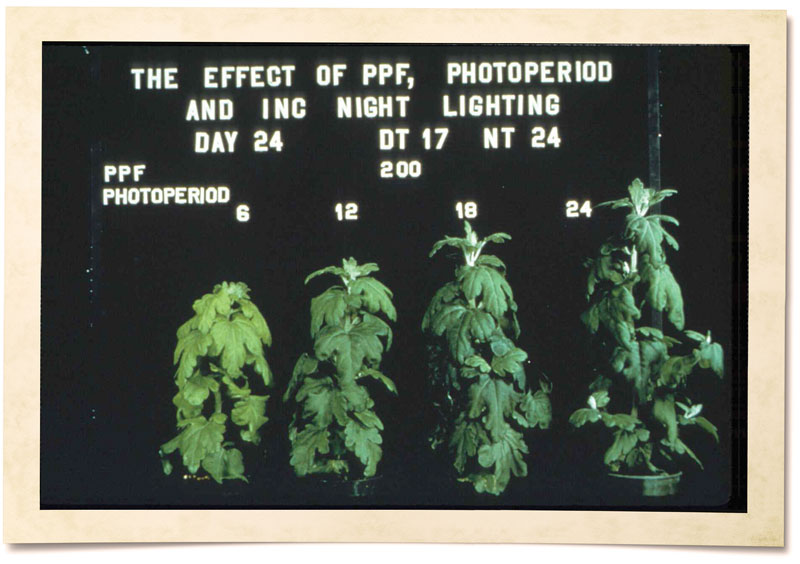
DIF: Back to basics
Temperature affects plant stem elongation and height. Plant height (stem elongation) increases as day temperature (DT) increases and night temperature (NT) decreases. The relationship between DT and NT is the key to understanding DIF, a term the researchers coined to describe that relationship: DT – NT = DIF.
When DT is less than NT, DIF is negative; when DT is greater than NT, DIF is positive. Plant stems grow longer (height increases) as DIF increases from a negative to a positive number. Conversely, plant stems elongate less as DIF decreases.
Pictured: A chrysanthemum responds differently to DIF under different daylengths. A plant’s response to negative DIF is greater under short days than long days.
“When people say DIF, often the implication is that you’re talking only about controlling or limiting stem elongation or plant height,” said Dr. Royal Heins, professor emeritus at Michigan State University. “DIF is a continuum of plant responses to day and night temperatures. It’s not just for limiting stem elongation; I can also deliver a positive DIF and promote elongation when plants are too short.”
Royal also adds that most plants respond to DIF (bulbs are an exception). That means you can apply DIF principles to help regulate bedding plant stem elongation, from plugs to finished plants. Julie Iferd, head grower at Catoctin Mountain Growers in Detour, Maryland, agrees.
“I think DIF works well on most crops, but it does work better on some than others,” she explained. “I find poinsettias and hydrangeas to be very responsive to DIF, whereas say with impatiens, you might have some effect, but water management is much more influential on stem elongation than anything a DIF can accomplish.”
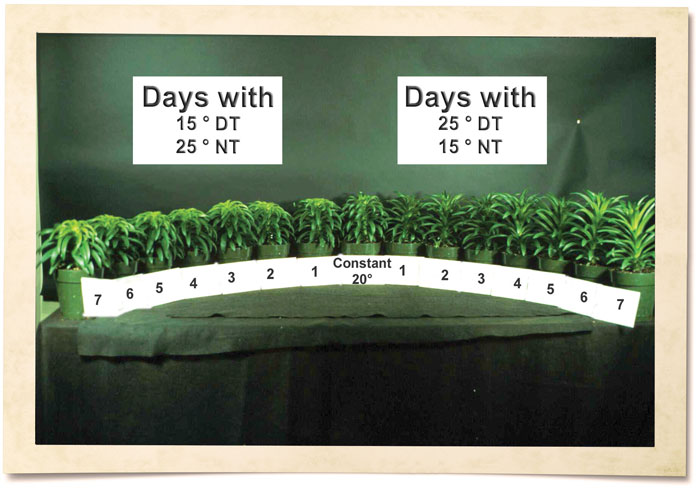
Why use DIF on bedding?
DIF offers plenty of benefits when it’s used on bedding plants. Here are just a few:
• Day-to-day control of stem elongation. “You can adjust whether you want to increase or decrease stem elongation daily,” says Dr. John Erwin, University of Maryland. “If you apply a plant growth regulator and the weather changes, sometimes plants can be shorter than desired. If using DIF, you can increase or decrease elongation daily regardless of the weather.”
Pictured: Plants respond on a daily basis to DIF. Here you can see how Easter lily responds to DIF based on days at negative (left) and positive (right) DIF.
• Cost savings. DIF can save you money in two ways: First, it can reduce growth regulator chemicals and labor costs. Second, if you’re using a negative DIF by dropping temperatures at the end of the night and beginning of the day, you can save on heating costs.
• Re-entry issues. Products like B-Nine (24-hour re-entry in some states) can have long REIs, which can make spraying them difficult labor-wise. Using DIF eliminates these labor logistics issues.
• No chemicals on edibles. If you’re growing edibles—vegetables or herbs—you can’t apply many chemicals. “You can use some growth retardants early in tomato, eggplant and pepper transplant production, but after that, DIF is the only option to control elongation,” John says. “For organic herbs, you can only use DIF.”
The morning DIP
“What most bedding growers use to limit stem elongation is what’s known as a morning DIP,” John says. The morning DIP is basically a drop in temperature at the end of the night and beginning of the day. Plants elongate most at the end of the night and beginning of the day, so dropping temperatures at that time reduces plant height most. The morning DIP lets growers reduce stem elongation without reducing greenhouse average daily temperatures much, which would increase crop time.
“The bigger the drop in early morning temperature, the more stem elongation is reduced,” John says. “People generally drop temperatures 7 to 10F at the end of the night and beginning of the day.” Generally, most bedding plant growers drop late night/early morning temperatures to 55 to 57F between 6:00 and 9:00 a.m.
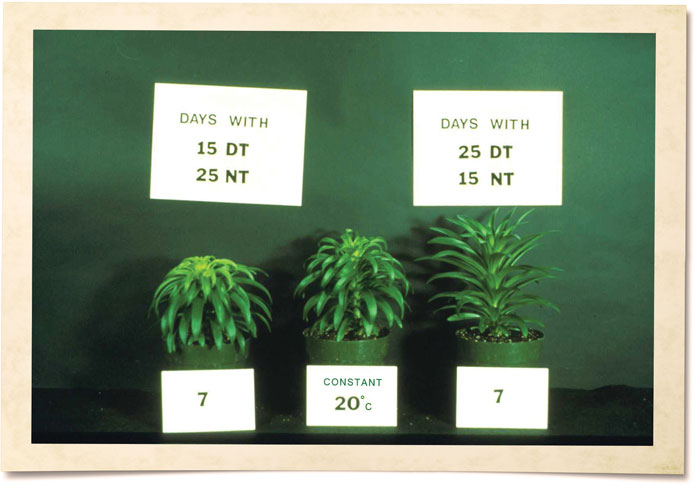 For growers with thermal energy curtains, achieving the morning DIP is a two-step process.
For growers with thermal energy curtains, achieving the morning DIP is a two-step process.
“We typically drop the heat set point at 4:00 a.m. so the greenhouse starts cooling down,” Julie explains. “Then 30 to 40 minutes before sunrise, we open the curtains and we typically see a sharp drop in temperature at that moment. Most of the time this is a significant enough drop to make the DIP effective. When outside temperatures are warm or if we need a strong negative DIF, we may actually vent the greenhouses, too.
Pictured: Notice the difference in how Easter lilies respond, after seven days, to negative DIF (left) and positive DIF (right).
“We typically keep the cooler set point until midmorning, when solar radiation starts to warm the greenhouse naturally. We maintain a moderate daytime temperature (not as cool as early morning) to ensure our average daily temperature is as optimum as possible for quick flowering.”
The most important aspect of using a morning DIP is timing the cool temps to just before dawn. This is relatively easy to do for a grower with unit heaters.
“About 30 minutes before sunrise, you lower the heating set point,” Royal says. “If you’re heating with hot water in pipes, you have a larger thermal mass, so it’s important to reduce the heating set point 60 to 90 minutes before sunrise so the heat in the pipes dissipates by sunrise.”
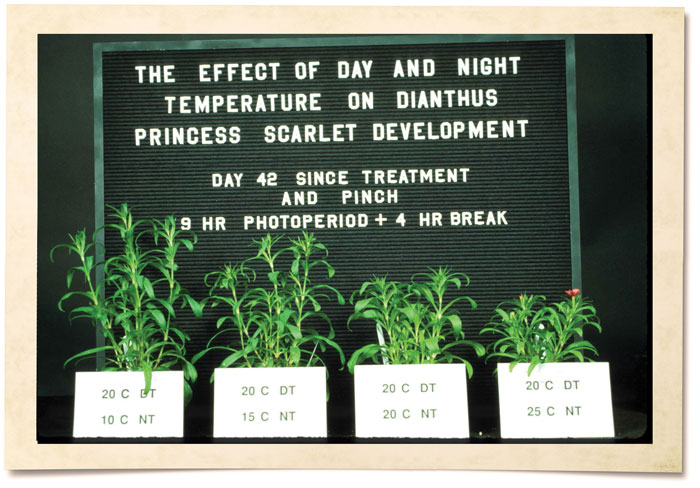
Regional impacts with DIF & DIP
Where you’re growing plays a role in using morning DIF or DIP. In Florida, for instance, DIP isn’t as effective in summer.
“During warm periods of the year, nights temps can be too high to get a DIP at first light,” John explains. “In contrast, in California, the morning DIP can be very effective because you have cool night temps and high light.
“By the way, the higher light levels are, the more effective DIF is. We don’t completely understand why light intensity affects DIF, but growers do get a bigger DIF response in Colorado or California where light levels can be higher than in Michigan or Ohio during spring when days can be cloudy.”
Pictured: Dianthus Princess Scarlet response to DIF.
With respect to DIF, growers in cold, cloudy climates like Michigan, Ohio, Illinois or Wisconsin typically have thermal curtains, so “it costs less to heat a greenhouse with negative DIF,” Royal says. “Negative DIF on an energy usage basis is most beneficial in these cold, cloudy regions. In sunny areas like California, Colorado or the Southeast, solar radiation increases in February and March. Trying to maintain a specific average daily temperature with a negative DIF would be more costly than with a positive DIF.”
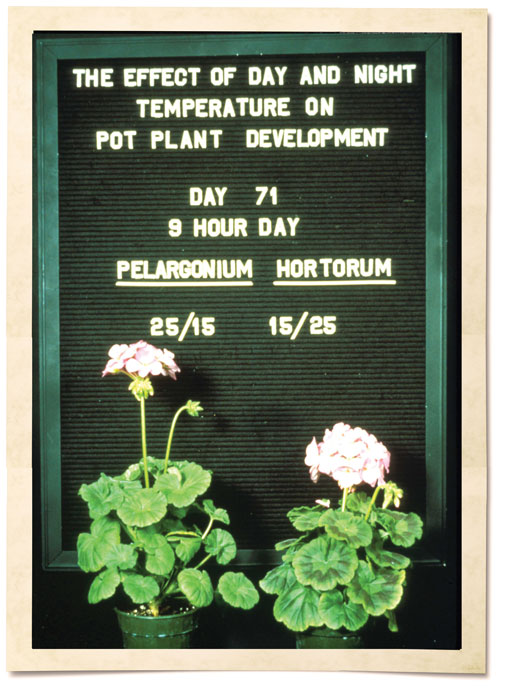
Practical tips for using DIF
Several common problems surface when growers use negative DIF to limit bedding plant height. Follow these practical hints to get the best results:
Pictured: Seed geranium response to DIF at flowering.
• Adjust chemicals. For first-time negative DIF/DIP users, John recommends using less plant growth regulators, especially the stronger ones like Bonzi or Sumagic. “You don’t want to reduce stem elongation too much and make your plants too short,” he warns.
• Remember cold-sensitive crops. “The bedding plants you need to worry about are the cold-sensitive ones,” John says. “With basil and cilantro, you can’t drop temperatures below 50F ever or you’ll get leaf bronzing. In general, with cold-sensitive annuals like these, you can stunt growth too much.”
• Crop timing. “If you keep day temps cool all day to get a maximum DIF response, you’ll reduce average daily temperature and increase crop time,” John says. This is why many growers prefer to use DIP.
• Fine-tune irrigation. A cool day temp means plants will use less water. Adjust watering to avoid disease issues.
• Leaf color. When growing with a negative DIF all day, plants can have a lighter color that when grown with a positive DIF.
- Avoid a sudden heat boost at dawn. “If your morning temperature increases rapidly at first light, that actually stimulates stem elongation,” John explains. “This might happen with older thermostats that change to day temps fast. Aim to increase temperatures gradually, using a ramping-up effect.”
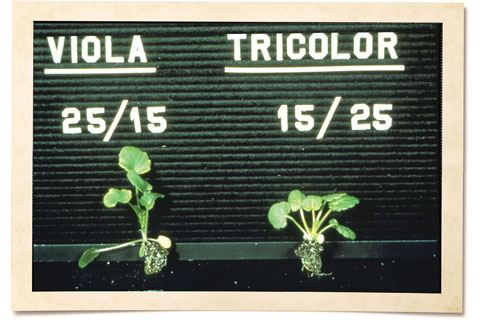
Want more research you can use?
University researchers like the team that developed DIF are eager to tackle industry issues. AFE welcomes feedback and suggestions from the industry to help identify key research needs. Reach out to Dr. Terril Nell to share your ideas and needs—your problem might become the next AFE-funded study! Also, consider a tax-deductible contribution to AFE; it’s an investment with a terrific return. Industry-funded research benefits every grower when AFE is behind it. Reports on DIF and other AFE-funded research are available at endowment.org.
Pictured: Pansy under positive and negative DIF.
All photos taken by Dr. Royal Heins, circa 1986
Julie Martens Forney is a freelance writer with more than 25 years of experience writing about floriculture industry issues and gardening for consumers. To read her current bylines, check out SAF’s Floral Management, HGTV.com and DIYNetwork.com. Julie’s also an avid gardener, tending edibles and perennials in a wildlife-friendly garden that features year-round color.